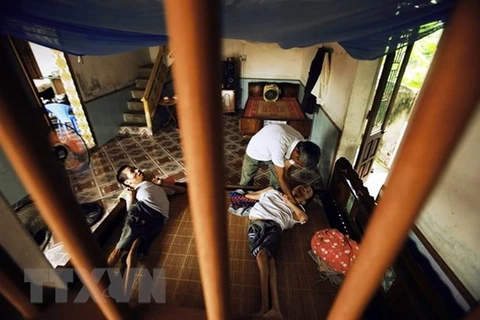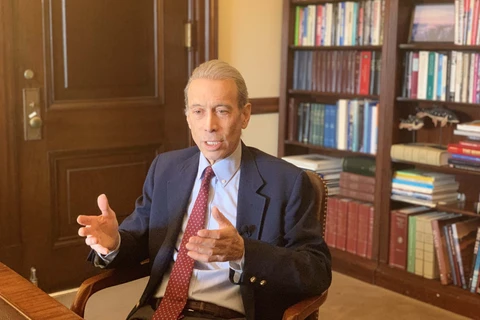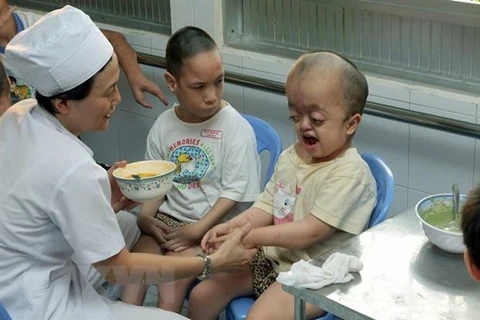 Lai Van Bien, a resident of Vu Thu district, Thai Binh province, take care of his two sons affected by chemical weapons (Photo: VNA)
Lai Van Bien, a resident of Vu Thu district, Thai Binh province, take care of his two sons affected by chemical weapons (Photo: VNA) Hanoi (VNA) – The war has been over for nearly half a century. However, millions of Vietnamese exposed to Agent Orange (AO)/dioxin continue to suffer from its consequences on a daily basis.
The US for the first time used aircraft to spray toxic chemicals over the south of Vietnam on August 10, 1961. The US army sprayed some 80 million litres of toxic chemicals, 61 percent of which was AO containing 366 kilograms of dioxin, over 3.06 million hectares, or nearly one quarter of the total area of southern Vietnam, from 1961 to 1971.
Statistics showed that 4.8 million Vietnamese people were exposed to AO/dioxin, and about 3 million people became victims. Nearly half a century has passed, but the AO/dioxin pains remain, passing from one generation to the next.
Easing the AO pains
Sen. Lieut. Gen Nguyen Van Rinh, Chairman of the Vietnam Association of Victims of AO/dioxin (VAVA), said that the war ended 45 years ago but the “AO pains” persist. Hundreds of thousands of victims lost their lives while millions of others suffer from fatal diseases, birth deformities or are in a vegetative state, including their offspring.
Many women could not become mothers and it is an extreme source of pain of the whole nation and progressive mankind.
The Party, State and people have paid attention to assisting victims of AO/dioxin. Each year, the State allocates thousands of billions of VND to support people who rendered services to the nation and AO/dioxin victims.
Of note, in May 2015, the Secretariat of the 11th Party Central Committee issued Direction No. 43-CT/TW on enhancing Party’s leadership in handling consequences of toxic chemicals used by the US during wartime in Vietnam. The direction holds great humanitarian values and demonstrates the sentiments and sense of responsibility of the Party and people to the victims.
Deputy Director General of Department of Social Protection under the Ministry of Labour, Invalids and Social Affairs Pham Thi Hai Ha said that the Party and State have devised policies on care for people who rendered services to the country, those who took part in the resistance war and their children affected by toxic chemicals.
The State, ministries and sectors have rolled out various legal documents to build the legal framework along with mechanisms and policies in a joint effort to help them overcome hardships and integrate into society, she added.
More than 320,000 people who joined the resistance wars and were exposed to toxic chemicals, along with their children have been verified as eligible for support. Nearly 3 million people have been verified as living with disabilities, including AO/dioxin victims.
State-funded support is provided in most aspects, from monthly allowances, free-of-charge health insurance, correction surgery, rehabilitation treatment, to vocational training.
Over 30 trillion VND (1.3 billion USD) is earmarked from the State budget for assistance to policy beneficiaries each year and in excess of 17 trillion VND is spent on paying monthly allowances and health insurance procurement for them.
Rinh added that, since 2015, VAVA chapters have raised more than 1.55 trillion VND. The amount was over 355 billion VND in 2019 alone.
The fight for justice for AO/dioxin victims is also in line with the Party’s foreign policy and gradually obtained positive results. The US government has recognised the tremendous and severe impact caused by toxic chemicals during the war in Vietnam, the official reiterated.
Unceasing efforts
Data showed that about 100,000 people who fought in the resistance war have yet to enjoy preferential policies due to losses of documents, Rinh said.
He voiced his hope that the Party, State and authorities of all levels will continue to pay heed to AO/dioxin victims, especially those of the third and fourth generations who are not eligible for support.
For her part, Ha said that the Department of Social Protection will work with relevant agencies to review legal documents on people with disabilities and exposed to chemicals toxins, in order to timely revise and address bottlenecks.
“Resurrecting” dead lands
More than 80 million litres of poisonous chemicals were sprayed over southern Vietnam throughout 10 years. Toxins still remain in various localities, threatening people’s lives. Relevant agencies are exerting efforts to revive such “dead lands”.
Colonel Le Dinh Vu, Office Chief of the National Steering Committee on the Settlement of Post-war Unexploded Ordnance and Toxic Chemical Consequences (Office 701), said that the office signed a memorandum of intent with the United States Agency for International Development (USAID) on support for people with disabilities in Vietnam, including AO/dioxin victims.
The Office 701 has also bolstered cooperation with the US and Japan in handling chemicals remnants in hotspots like Da Nang, Bien Hoa and Phu Cat airports, Vu added./.
























